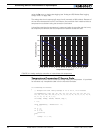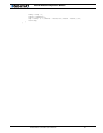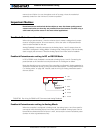
AX500 Motor Controller User’s Manual 65
Feedback Potentiometer wiring
manner that will allow it to turn throughout much of its range, when the mechanical
assembly travels from the minimum to maximum position.
Important Notice:
Potentiometers are mechanical devices subject to wear. Use better quality potenti-
ometers and make sure that they are protected from the elements. Consider using a
solid state hall position sensor in the most critical applications.
Feedback Potentiometer wiring
When using a potentiometer, it must be wired so that it creates a voltage that is propor-
tional to its angular position: 0V at one extreme, +5V at the other. A 10K potentiometer
value is recommended for this use.
Analog Feedback is normally connected to the Analog Inputs 1 and 2, except when the
controller is configured in Analog Mode. In Analog mode, Analog Inputs 1 and 2 are already
used to supply the command. Therefore Analog inputs 3 and 4 are used for feedback
Feedback Potentiometer wiring in RC or RS232 Mode
In RC or RS232 mode, feedback is connected to Analog Inputs 1 and 2. Connecting the
potentiometer to the controller is as simple as shown in the diagram on below.
Note that this wiring must not be used if the controller is configured in Analog mode but is
switched in RS232 after power up using the method discussed in “Entering RS232 from R/
C or Analog mode” on page 105. Instead, used the wiring for Analog mode discussed in
the next section.
Feedback Potentiometer wiring in Analog Mode
When the controller is configured in Analog mode, the analog inputs 1 and 2 are used for
commands while the analog inputs 3 and 4 are used for feedback. Analog inputs 3 and 4
have different characteristics than inputs 1 and 2, and so require a lower resistance poten-
tiometer in order to guarantee accuracy
10 Ana2
14 +5V
5 Ground
11 Ana1
8 Ana4*
12 Ana3*
Feedback 1
Feedback 2
2k - 10k 2k - 10k
FIGURE 36. Pot wiring for RS232 or RC Command and Analog Feedback


















